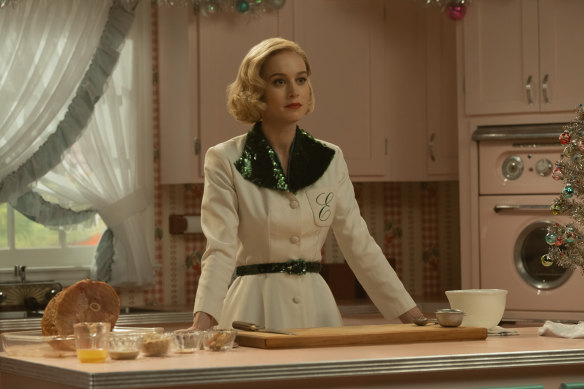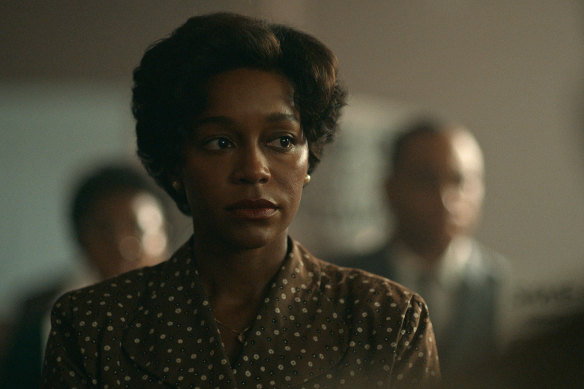Save articles for later
Add articles to your saved list and come back to them any time.
An air of excitement and some apprehension always accompanies the TV adaptation of a beloved book. Will the screen version do it justice and create something equally exciting? Or will it tarnish the memory of the book by adding a regrettable postscript? Lessons in Chemistry inspires such questions.
Bonnie Garmus’ witty charmer is a publishing-industry phenomenon: the debut novel by a woman in her mid-60s that last year became a breakout bestseller. Charting the triumphs and tragedies of American research chemist and cooking-show host Elizabeth Zott through the 1950s and early ’60s, the book has an admirable economy and verbal precision that’s possibly a product of Garmus’ days as a copywriter. It’s also distinguished by an irresistible vitality, vibrant characters and incisive humour.
Brie Larson stars as Elizabeth Zott in Apple TV’s adaptation of Bonnie Garmus’ book Lessons in Chemistry.
In addition to its international success, which suggests the existence of an already receptive audience, Lessons in Chemistry’s ingredients make it an attractive TV proposition. It’s built around a strong, smart and spirited heroine who battles discrimination and adversity. It has a romcom thread involving the disarming union of two gifted outcasts. The period setting allows for an exploration of the values of the era, as well as potentially eye-catching production and costume design.
And there’s more.
It’s also an off-beat and affecting mother-daughter story and the tale of a television trailblazer. And because the trail that she blazes involves a cooking show, there’s scope for yummy food shots. As a final bonus, there’s an adorable dog. Bingo. Laydown misere.
Adapted for TV by Lee Eisenberg (who co-created Jury Duty and adapted WeCrashed) and starring and co-executive produced by Oscar-winner Brie Larson (Room, Captain Marvel), the eight-part series (Apple TV+) begins, like the book, with Elizabeth hosting a popular daytime cooking show. Its devoted female following mystifies many of the men around her.
Presenting Supper at Six in crisp, businesslike fashion, Elizabeth approaches cooking with the same mindset that she applies to her scholarly research on abiogenesis. She creates a more functional workspace by clearing away the kitsch clutter intended to conjure a homey atmosphere in the extravagantly pink “dream kitchen” set that’s been designed by her well-meaning producer (Kevin Sussman). And there are no frilly little aprons for this gal, in spite of the boorish, bullying network boss (Rainn Wilson) demanding, “Big hair, tight dress, sexy set.”
Calvin Evans (Lewis Pullman) is as much of a loner and an outcast at Hastings as Elizabeth (Brie Larson).Credit: Apple TV+
From the outset, Larson is the embodiment of Garmus’ earnest, briskly efficient protagonist: a beautiful blonde oblivious to how gorgeous she is and blithely unconcerned with such distractions anyway. The opening establishes the success of Elizabeth’s show and her calm yet resolute practice of going her own way. Providing tasty, budget-conscious and nutritious meals that can be quickly assembled is a task that she takes seriously. She doesn’t underestimate or belittle it, which is inspiring to her viewers, and she encourages them to experiment and not to fear failure.
A flashback then reveals how she got to that studio, having escaped the hostile environment of the Hastings Research Institute, where she was misemployed as a lowly lab tech. She’s clearly the smartest person in the room, yet the men around her are condescending, exploitative and often casually insulting. Meanwhile, the other women just don’t get her: she’s not interested in hooking a husband or winning the company’s beauty pageant. The opening scenes at the TV station and the chemical company emphasise the stifling restrictions and prevailing prejudices that have long fuelled female fury.
However, the drama really comes alive when the romcom element kicks in and Elizabeth meets Calvin Evans (Lewis Pullman), who’s as much of a loner and an outcast at Hastings as she is, albeit for different reasons. A vaunted Nobel Prize contender, he’s afforded a latitude that the lesser chemists can only dream about, and his colleagues are envious.
The most significant shift from the novel comes with the portrayal of neighbour Harriet, played by Aja Naomi King.Credit: Apple TV+
After a meet-cute in which her homemade lunches become a handy temptation as well as a revelation to a man who’s existed on the basic fuel of dry biscuits and vending-machine nuts, the characters’ chemistry is beautifully balanced as they bond over beakers and blackboard equations.
The most significant shift from the novel comes with the portrayal of a neighbour. In the book, she’s a down-trodden middle-aged woman who becomes a babysitter and then a friend for Elizabeth. In the series, it’s Harriet (Aja Naomi King), a young Black mother, doctor’s wife and community activist.
Like Elizabeth, Harriet’s a clever and capable woman, and her inclusion allows the series to explore racism as well as sexism. It also enables discussion about the joy and pain of motherhood after Elizabeth has baby Madeline (played as a young girl by a well-cast Alice Halsey).
The connection between their battles is made explicit when Harriet talks of “people struggling to be seen, begging to be treated with dignity”. And with that comes an indication of the drama’s biggest problem: its tendency to make explicit what’s already been effectively implied. It’s not that the position is hard to support: standing up to chauvinists, racists and bullies is laudable; and it’s important to stay true to yourself. They’re principles that are hard to dispute, although they also fall into the category of motherhood statements.
Whereas one of the defining attributes of Garmus’ book is its light touch, the series is crafted with a heavier hand. Although it’s enjoyable, it lacks subtlety. Amid the colourful costume and production design, the issues foregrounded are rendered in black and white.
In a revealing sign of its impulses, Six-Thirty, the smart and sensitive dog described in the book as “tall, grey, thin”, is here played by a presumably more telegenic goldendoodle. Alas, like the book, he’s been given more of a Hollywood makeover than was required.
Find out the next TV, streaming series and movies to add to your must-sees. Get The Watchlist delivered every Thursday.
Most Viewed in Culture
From our partners
Source: Read Full Article


